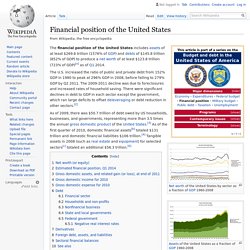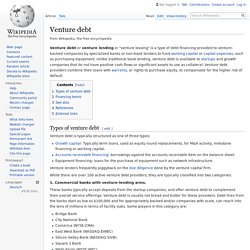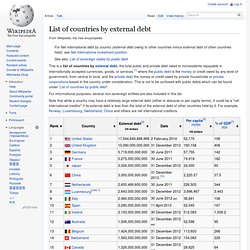

Financial position of the United States - Wikipedia. Net worth of the United States by sector as a fraction of GDP 1960-2008 Assets of the United States as a fraction of GDP 1960-2008 The financial position of the United States includes assets of at least $269.6 trillion (1576% of GDP) and debts of $145.8 trillion (852% of GDP) to produce a net worth of at least $123.8 trillion (723% of GDP)[a] as of Q1 2014.

The U.S. increased the ratio of public and private debt from 152% GDP in 1980 to peak at 296% GDP in 2008, before falling to 279% GDP by Q2 2011. The 2009-2011 decline was due to foreclosures and increased rates of household saving. There were significant declines in debt to GDP in each sector except the government, which ran large deficits to offset deleveraging or debt reduction in other sectors.[2] Net worth (or equity)[edit] The net worth of the United States and its economic sectors has remained relatively consistent over time. Estimated financial position, Q1 2014[edit] Gross domestic income for 2010[edit] SOURCE: U.S.
SOURCE: U.S. Challenge.gov. Home. Advanced Data Search. Venture debt - Wikipedia. Types of venture debt[edit] Venture debt is typically structured as one of three types: Growth capital: Typically term loans, used as equity round replacements, for M&A activity, milestone financing or working capital.Accounts receivable financing: borrowings against the accounts receivable item on the balance sheet.Equipment financing: loans for the purchase of equipment such as network infrastructure.

Venture lenders frequently piggyback on the due diligence done by the venture capital firm. While there are over 100 active venture debt providers, they are typically classified into two categories: 1. These banks typically accept deposits from the startup companies, and offer venture debt to complement their overall service offerings. Bridge BankCity National BankComerica (NYSE:CMA)East West Bank (NASDAQ:EWBC)Silicon Valley Bank (NASDAQ:SIVB)Square 1 BankWells Fargo (NYSE:WFC) 2.
Commercial banks at times can be limited in the dollar size of the loans, or strict covenants attached. Consumer debt. In recent years, an alternative analysis might view consumer debt as a way to increase domestic production, on the grounds that if credit is easily available, the increased demand for consumer goods should cause an increase of overall domestic production.

The permanent income hypothesis suggests that consumers take debt to smooth consumption throughout their lives, borrowing to finance expenditures (particularly housing and schooling) earlier in their lives and paying down debt during higher-earning periods. Both domestic and international economists have supported a recent upsurge in South Korean consumer debt, which has helped fuel economic expansion. On the other hand, credit card debt is almost unknown just across the sea in Japan and China, because of long-standing cultural taboos against personal debt. Theoretical underpinnings aside, personal debt is on the rise, particularly in the United States and the United Kingdom. Household debt - Wikipedia. Household debt is defined as the amount of money that all adults in the household owe financial institutions.

It includes consumer debt and mortgage loans. A significant rise in the level of this debt coincides historically with many severe economic crises and was a cause of the U.S. and subsequent European economic crises of 2007–2012. [citation needed] Several economists have argued that lowering this debt is essential to economic recovery in the U.S. and selected Eurozone countries.[1][2][3] Overview[edit] List of countries by external debt. This is a list of countries by external debt, the total public and private debt owed to nonresidents repayable in internationally accepted currencies, goods, or services,[1] where the public debt is the money or credit owed by any level of government, from central to local, and the private debt the money or credit owed by private households or private corporations based in the country under consideration.

This is not to be confused with public debts which can be found under 'List of countries by public debt'. For informational purposes, several non-sovereign entities are also included in this list. Note that while a country may have a relatively large external debt (either in absolute or per capita terms), it could be a "net international creditor" if its external debt is less than the total of the external debt of other countries held by it.
For example, Norway, Luxembourg, Switzerland, China and others are net international creditors.